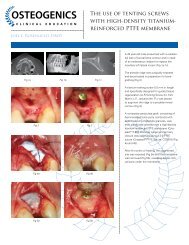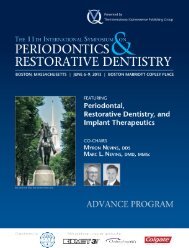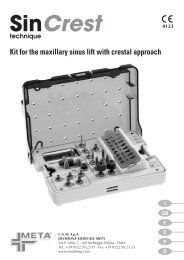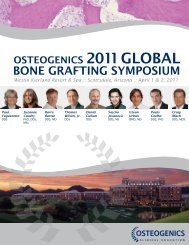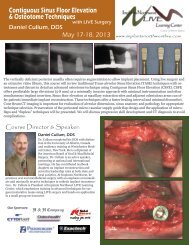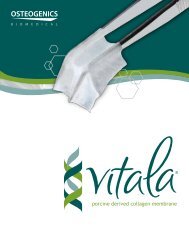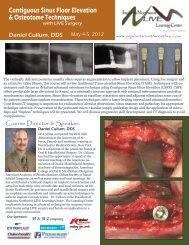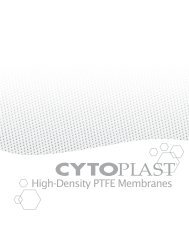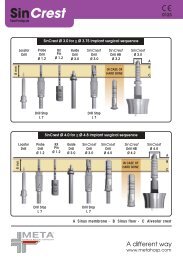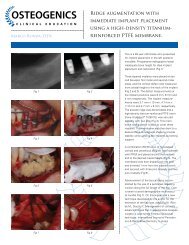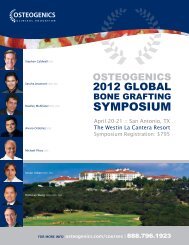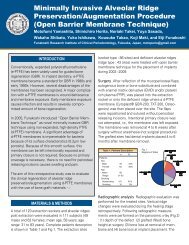Titanium-Reinforced Non-Resorbable PTFE Barrier ... - Osteogenics
Titanium-Reinforced Non-Resorbable PTFE Barrier ... - Osteogenics
Titanium-Reinforced Non-Resorbable PTFE Barrier ... - Osteogenics
Create successful ePaper yourself
Turn your PDF publications into a flip-book with our unique Google optimized e-Paper software.
during placement of the membrane to prevent delamination. Trimming of the membrane close to the titanium frame<br />
or excessive bending of the frame can increase the risk of delamination. Sections of the membrane that become<br />
delaminated during placement should not be used. In rare instances, the titanium frame may perforate through the<br />
<strong>PTFE</strong> material during handling. If this occurs, the membrane should not be used.<br />
If additional stability is desired, the membrane may be stabilized with sutures, surgical tacks or screws. The use of a<br />
non-resorbable monofilament suture is recommended by the manufacturer. Loss of tensile strength during the initial<br />
2-week healing period can lead to premature membrane exposure.<br />
Adequate flap release must be accomplished in order to achieve a tension-free closure if primary closure is desired.<br />
Vertical incisions, if used, must be remote from the location of the membrane. A double layer closure, with a deep layer<br />
of horizontal mattress sutures followed by a standard wound closure with interrupted sutures, is recommended.<br />
MEMBRANE EXPOSURE<br />
Depending on the size and complexity of a given defect, maintenance of primary closure may be required for<br />
predictable bone regeneration. If primary closure is desired, and premature exposure of the membrane occurs,<br />
the manufacturer recommends following recognized published protocols for management and prevention of <strong>PTFE</strong><br />
membrane exposures.<br />
MEMBRANE REMOVAL<br />
When removal is desired, the membrane may be easily removed, if exposed, by grasping with forceps and gently<br />
removing it from the tissue. Anesthesia may be provided to enhance patient comfort, but is usually not necessary. If<br />
primary closure is obtained at placement, surgical exposure may be required for removal.<br />
Following membrane removal, the regenerated tissue will re-epithelialize within 14 to 21 days to complete the<br />
initial healing process. However, final bone maturation will not occur for 6 to 12 months. This time frame should be<br />
considered in treatment planning cases involving heavy prosthetic loading of regenerated bone.<br />
AVAILABILITY<br />
Cytoplast® Ti-250/Ti-150 <strong>Non</strong>-<strong>Resorbable</strong> <strong>Barrier</strong> Membranes are provided sterile in a variety of shapes and sizes,<br />
and are titanium reinforced.<br />
3



